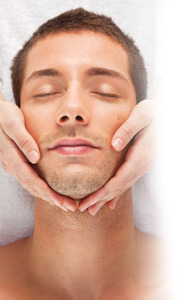THE MODERN MALE

From the gym to the grocery store, men are becoming more conscious of what they eat and how they take care of their bodies. This amplified awareness has also fueled a noticeable increase in the number of men heading to spas and physicians’ offices to further polish their appearances. The International Spa Association reports that nearly one-third of spa clients are now men. If you are not marketing to men and cultivating your current relationships with your male clients, you are missing out on an easy way to advance your business. When Men’s Health asked celebrities about their favorite guy ritual, Hall of Fame baseball player Dave Winfield said, “A manicure or pedicure, like the girls do.
 Don’t let them have all the fun!” Many men agree with Dave. Spa offerings including nail care, facials, massages and laser treatments have crossed over into male territory. In fact, a report from Euromonitor International, a company that provides strategy research for consumer markets, has data to show that more men are buying lotions and potions to enhance their skin and improve their appearance – and it is big business. The company predicts the men’s grooming market in the United States will grow to nearly $5.8 billion by 2016, and when it comes to men undergoing cosmetic procedures, those numbers are up by more than 100 percent since 1997.1
Don’t let them have all the fun!” Many men agree with Dave. Spa offerings including nail care, facials, massages and laser treatments have crossed over into male territory. In fact, a report from Euromonitor International, a company that provides strategy research for consumer markets, has data to show that more men are buying lotions and potions to enhance their skin and improve their appearance – and it is big business. The company predicts the men’s grooming market in the United States will grow to nearly $5.8 billion by 2016, and when it comes to men undergoing cosmetic procedures, those numbers are up by more than 100 percent since 1997.1
A Guy Guide
While men are becoming more comfortable in a spa setting, their needs may still be different from those of your majority female clientele. Men have different trigger points. For the most part, a man’s desire to go to a spa is less about beautification and pampering and more about just looking well-kempt (however, both men and women cite decreasing stress as a great spa benefit). To accommodate clients of all genders, consider centering your décor around earth tones and cooler neutral colors.
It is also important to point out that the male spa market is being driven by Generation X and the Millennials. Mintel, a global market research group, reports that 38 percent of men ages 18 to 34 have had a facial or body treatment compared to only 15 percent of men over the age of 55. That does not mean limiting your marketing to just that age group, but the young adult demographic is likely where much of your male business will come from. With that said, let us look at a few treatments that are coveted by the male clientele.
A Fresh Take on Facials
When it comes to facial treatments, men have many of the same desires as women: reducing fine lines and wrinkles, improve acne, erase sun damage, and, depending on the treatment, enjoy an hour or so to relax. However, it can be very effective to differentiate your treatments from a marketing standpoint. Instead of calling a treatment a spa rejuvenation facial, you can label your services with names like active sun relief or facial fitness treatment. Another option is to create signature facials that incorporate ingredients like beer and barley.
To give your clients even faster results, opt for the use of cosmetic laser, intense pulsed light (IPL) and radio frequency (RF) technology. Procedures like fractional laser rejuvenation, IPL photofacials and RF skin tightening can help you address the problem areas male clients typically cite as concerns, such as crow’s feet, laugh lines and sagging skin. If your client is laser-shy, let him know that plenty of other men are getting these treatments. In 2012, nearly two million non-surgical skin rejuvenation procedures were performed on men.2
Training to perform laser wrinkle reduction, skin tightening and other medical aesthetic procedures can increase your offerings of procedures that both men and women are asking for by name. The industry standard for training is a 15-day comprehensive course – however cosmetic laser laws regulations vary from state to state, so it is a good idea to check with a national medical aesthetics training institute to learn about regulatory practices where you live.
 Manscaping
Manscaping
A study on male hair removal trends conducted at the psychology department at Findlers University in Australia discovered that “hairlessness is rapidly becoming a component of the ideal male body.” The 2008 research report also stated that when removing hair on the back, buttocks or pubic area, “the primary reason for [hair removal] is to maintain or improve their appearance.”
There are several methods of professional hair removal, but two of the most popular are waxing and laser hair removal. Waxing will typically give guys up to two weeks of smooth skin, while laser hair removal can achieve up to 90 percent hair reduction following six to eight treatments. Because of its convenience and the ability to remove hair without ripping it out by the roots, laser hair removal has become the go-to procedure for many men who want a smooth physique. Last year, more than 750,000 laser hair removal procedures were performed on men.3
Massages
According to 2012 statistics from the American Massage Therapy Organization, 10 percent of men reported getting a massage within the year. The survey also showed that for those who have had a massage, nearly one-third had at least one massage therapy session to relieve stress. Other indications for massage include pain management, treatment of injuries and headaches, and overall wellness.
Detoxing for Dudes
As mentioned earlier, many guys are interested in the overall care of their bodies, which includes diet and exercise. Therefore, many of your clients may also be interested in other ways to boost their overall well-being and improve their appearance from the inside out. This could include detoxifying spa treatments or helping them find new tools that can assist them in improving their health.
Clients who receive detoxification treatments say that they see many benefits including increased energy, clearer skin and less stress, among other advantages. Whether you perform detoxification treatments as part of your services or refer your clients to another practitioner, these treatments can complement and enhance the aesthetic services you provide.
Dry Skin Brushing
Dry skin brushing helps to shed dead skin cells and improve circulation while stimulating the lymphatic system. This can be integrated with a service like a manicure, pedicure or massage (dry brushing the arms, legs or body), or offered as an add-on treatment to any service.
 Sauna Detox
Sauna Detox
To help the body release toxins, your spa may want to invest in a sauna. Saunas help with detoxification as they induce sweating which allows for the mobilization and excretion of impurities. Using a sauna is a great detoxification treatment, especially when used in conjunction with exercise, massage, constitutional hydrotherapy, and/or colon hydrotherapy. Detox sauna protocols vary from practitioner to practitioner, and currently there is insufficient evidence to suggest an optimal sauna temperature for depuration.
The use of a sauna can have a cardiovascular effect, similar to that of moderate exercise, and it can cause some strain on the heart. Therefore, people with any type of cardiovascular issues should consult a physician before starting a detoxification program that includes a sauna.
 Promote Exercise
Promote Exercise
Promoting overall fitness is also a good idea. Aerobic exercise has been linked to weight loss and better cardiovascular health, including a decreased risk of heart disease. Many of the world’s top CEOs attribute their success in part to cardiovascular exercise. Anaerobic exercise is also important for men to improve muscle size and tone, as well as an increase in energy and testosterone levels. This can also be great for cross- promotion with gyms and other health and fitness businesses.
Offer Hydration
Water is crucial for good health and skin, so it is a good idea to remind your clients to keep well hydrated every day. A good rule for water consumption is to drink a minimum of half your body weight in ounces. For example, a 170-pound man should drink at least 85 ounces of water per day.
At your spa, be sure to have water available for your clients. If you use plastic bottles or containers, it is a good idea to use ones that are Bisphenol A(BPA)-free. Many plastics contain BPA, an industrial chemical that can seep into food and water. The National Institutes of Health recommends opting for glass, porcelain or stainless steel containers, and checking the recycling code on your plastic bottles.
Bringing in Business
Working with other local businesses is a great way to score new clients. The types of businesses that are good to reach out to are companies that cater to men’s health, but do not directly compete with you. With each business, set up a meeting with the manager or owner to discuss a mutually beneficial partnership. This partnership can be as simple as providing a free gift certificate for an introductory service and allowing the business’ employees to hand it out to new members or customers. This gives the business a way to reward clients with a great gift while increasing your visibility. Here are some industries to target:
- Gyms/Personal Trainers – Twenty three million men have gym memberships, according to the website Fitness for Weight Loss. That means the local gym is a perfect source of potential new clients.
- Nutritionists/Supplement Stores – Nutritionists and stores that sell dietary supplements can also be a good partner for your business. The Centers for Disease Control and Prevention (CDC), reports that more than half of Americans take a dietary supplement.
- Clothing Boutiques – From suits to designer jeans, menswear is big business. While it can be tough to strike a local deal with a corporate big box retailer, many locally owned clothing stores would likely be excited to build a partnership.
All-Inclusive
As you can see, expanding your business to accommodate the needs of both male and female clients can be fun, exciting and profitable. But remember that customer service is the cornerstone of any business. Once you get new clients in the door, be sure to give them personalized service that will inspire them to keep coming back… and to tell all of their friends about you.
As you expand your business, do not be afraid to change and tweak ideas as you go along. Just because you introduce an idea, it does not mean you have to stick with it if it is not working. So have fun and try out new ways to draw in clientele and set your business apart from all the rest!
References
- American Society for Aesthetic Plastic Surgery
- ibid
- ibid








